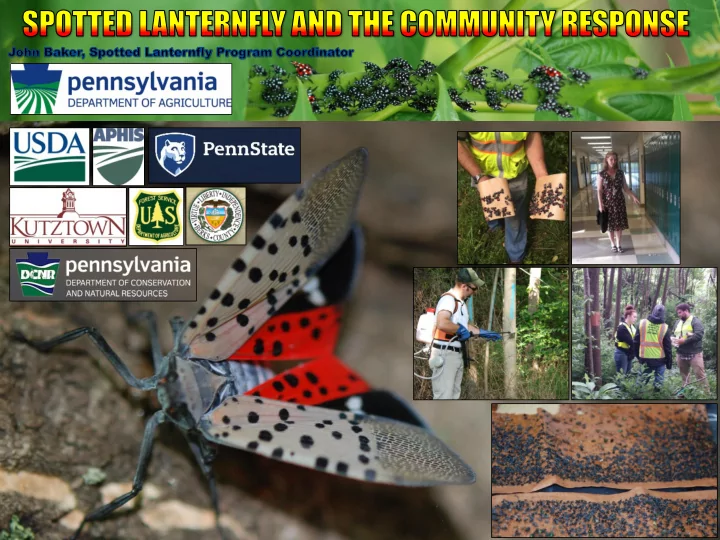

On September 22, 2014 the Entomology Program of the Pennsylvania Department of Agriculture received a report from an educator from the Pennsylvania Game Commission The report detailed damage to Ailanthus altissima (Tree of Heaven) on private property in Eastern Berks County, PA being caused by an unknown insect
Original photographs from report:
About the pest Community response
Lycorma delicatula (WHITE): A Planthopper in the Family Fulgoridae About 129 Genera, 696 Species in the world Only 9 Genera and 17 species in North America Christopher Marley Planthopper Formation Lycorma is represented by 7 species worldwide Like most planthoppers, Lycorma pierce the stems of plants or trees with their proboscis.
The spotted lanternfly is native to Asia and is found in China, Bangladesh, Vietnam It was introduced to Japan, South Korea and Pennsylvania In South Korea, it is considered an invasive pest and impacts grapes and peaches
Current Distribution:
2 Years of Banding indicates a central point of introduction
Impact: Kutztown University has started to develop a list of host plants used in PA The Kutztown studies have shown that early in their life, spotted lanternflies will make use of many plant species (78), but strongly prefer Tree of Heaven (Ailanthus altissima). As the insects become adults, they will feed almost exclusively on Tree of Heaven A list of hosts is available on this web-site from Penn State: http://extension.psu.edu/pests/spotted-lanternfly/news/2015/host-plants-used-by-spotted-lanternfly
Impact: Potential to damage grape, orchard, hardwood, and nursery industries In PA, populations have been detected in managed grapes, damage comes from adult feeding waste (honeydew)
Egg Laying: Adults: July 24-December September 19-November Eggs: October-June One Generation Per Year Fourth Instar: Hatch and 1st Instar: July 7-September May 12- June Third Instar: June 24-Mid July Second Instar: June 03- July
The eradication program relies on cooperation. Local officials, state agencies, and extension lead the organizational charge PDA crews, volunteers, property owners and businesses work in concert
SPOTTED LANTERNFLY NUMBERS THROUGH 2016 9,582 Trees Banded, Killing 564,510 Lycorma Egg mass scraping killed 1,064,070 Lycorma Ailanthus removal/trap tree setup underway
• The Volunteer Program • Community Calls • Invasive Species line and badbug
• Band your property • We give you the supplies • Training sessions • Volunteers report their data using PaPlants
• 2015: 150 bands, 15,536 SLF controlled • 2016: 123 bands, 46,035 SLF controlled
• Monthly calls with local officials and residents • Town hall talks – Well attended; 300 attendees at last town hall
• Hotline and BadBug reports: – 1474 Public reports investigated, 83.1% accurate Logging and quarantine concerns
THANK YOU http://www.agriculture.pa.gov/Protect/PlantIndustry/spotted_lanternfly
Recommend
More recommend